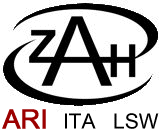Dynamics of galaxies, star clusters and planetary systems (MVSem)
Lecturers: Andreas Just, Rainer Spurzem
Winter term 2020/21 (2 SWS)
Wednesday 14:00 - 15:30, ARI seminarroom, first floor Online, see below.
This 'Masterpflichtseminar' is addressed specifically to master students, who
intend to obtain the mantadory 'MVSem' certificate required for
master studies. It is organised as a journal club, where every
topic usually consists of a seminar talk by the student presenting
one or more recent research papers. An additional written report of the presentation is required.
Registration
Please register here for participationONLINE teaching
This seminar will be held online via a Zoom platform. More detailed information, how to use Zoom and the link to join the meetings will be given by email to the registered participants.Time Plan
A presentation of possible topics, the choice of topics and time plan will be done in the first and second session (in brackets you find the available supervisors for each date). A list of topics as suggested by the lecturers can be found here. More and other suggestions are always welcome.
- 4.11. (AJ,RS) Planning Session
- 11.11. --
- 18.11. H. Köhn: J7. Evidence of a dynamically evolving Galactic warp
- 25.11. E. Hühn: S8. The fates of merging supermassive black holes and a proposal for a new class of X-ray sources;
M. Eberlein: S1. MSTAR - a fast parallelized algorithmically regularized integrator with minimum spanning tree coordinates - 2.12. A. Vani: J8. Evidence for Galactic disc RR Lyrae stars in the solar neighbourhood;
M. Alban: S9. Aligning Nuclear Cluster Orbits with an Active Galactic Nucleus Accretion Disk - 9.12. G. Wiest: J3. Post-Newtonian evolution of massive black hole triplets in galactic nuclei - IV. Implications for LISA;
C. Zimmermann: S5. A giant exoplanet orbiting a very-low-mass star challenges planet formation models - 16.12. P. Capone & P. Mercatoris: S4. The New Generation Planetary Population Synthesis (NGPPS)
- 13.1. A. Covelo: J5. Escapees from the bar resonances: Presence of low-eccentricity metal-rich stars at the solar vicinity;
F. Marx: S12. The role of disc torques in forming resonant planetary systems; - 20.1. P. Christians: J4. The Proper Motion of Sagittarius A*: III. The Case for a Supermassive Black Hole;
L. Hühn: S2. Dynamics of Planetary Systems within Star Clusters: Aspects of the Solar System's Early Evolution - 27.1. J. Müller: S10 Populating the upper black hole mass gap through stellar collisions in young star clusters;
D. Rodener: S6. On the Origin of GW190521-like Events from Repeated Black Hole Mergers in Star Clusters - 3.2. S. Demircian: S3. Effect of pebble flux-regulated planetesimal formation on giant planet formation;
N. Lorenz: J10. Galactic seismology: the evolving “phase spiral” after the Sagittarius dwarf impact - 10.2. H. Mazumdar: J9. Measuring the matter density of the Galactic disc using stellar streams;
J. Reichert: S13. Realistically Simulating Exoplanets within Stellar Clusters. I. Improving the Monte Carlo Approach; - 17.2. P. Saxena: S14. How Jupiters Save or Destroy Inner Neptunes around Evolved Stars;
A. Schirra: S17. Implementing Primordial Binaries in Simulations of Star Cluster Formation with a Hybrid MHD and Direct N-Body Method; - 24.2. -- (MSc exam week)
(Responsible for contents: Andreas Just)
Contact: A. Just

